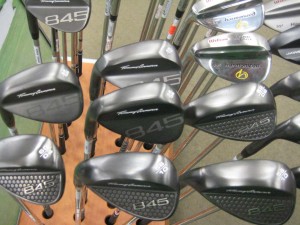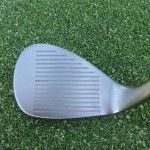Golf Wedge
 A golf wedge is essentially a golf iron that are used for shorter distance shots, usually from 100 yards and closer in to the green. A golf wedge is designed to hit the golf ball higher in the air and to put lots of back spin on the ball so it “sit” on the green (the ball doesn’t roll very far).
A golf wedge is essentially a golf iron that are used for shorter distance shots, usually from 100 yards and closer in to the green. A golf wedge is designed to hit the golf ball higher in the air and to put lots of back spin on the ball so it “sit” on the green (the ball doesn’t roll very far).
A golf wedge is also great for getting a ball out of tall grass, other types of rough, and out of the sand. They are able to do this because they have more loft than other irons. Golf wedge lofts can range from 48-64 degrees.
If you learn how to properly use your golf wedges it will increase your ability to shoot lower scores, so make your wedges your friend.
Types of Golf Wedges
There is the pitching wedge (PW) usually 45-48 degrees of loft, the gap wedge (GW) with a loft between a PW and SW (the Gap wedge is 50-54 degrees of loft, the sand wedge (SW) which has a loft between 54-58 degrees, and finally the lob wedge (LW) for those shots where you need the most height, like a flop shot.
The sand wedge was recently invented in the 1930’s (golf is an old game) by golf pro Gene Sarazen specifically for use in the sand or bunker. Sand wedges have what is called bounce preventing the sole of the club from digging to deep into the turf or sand.
Understanding Golf Wedge Bounce
 The sand wedge SW and LW are designed with a “bounce angle” so that when the sole of the club is flat on the ground there is a gap between the ground and the leading edge of the club face. Lifting the leading edge of the club off the ground gives a club bounce because it prevents the club face from biting into the sand or grass and digging in.
The sand wedge SW and LW are designed with a “bounce angle” so that when the sole of the club is flat on the ground there is a gap between the ground and the leading edge of the club face. Lifting the leading edge of the club off the ground gives a club bounce because it prevents the club face from biting into the sand or grass and digging in.
Instead a club designed with bounce will skid across the ground or only burrow a little ways into sand. Sand and lob wedges are designed with different amounts of bounce referred to as the bounce angle. The amount of bounce is given in degrees.
Good golfers can use bounce to their advantage by matching the amount of bounce on their wedges to the different conditions they normally play (thick tall rough, hardpan, tight-lies, firm or fluffy sand).
 They must also match the amount of bounce on their golf wedges to their individual styles of swings. Do they tend to hit down or dig with their wedges, or sweep or slide the club under the ball with a flatter angle of attack?
They must also match the amount of bounce on their golf wedges to their individual styles of swings. Do they tend to hit down or dig with their wedges, or sweep or slide the club under the ball with a flatter angle of attack?
To find the perfect golf wedge for you you must find out what type of swing you have? Or play around with some wedges with different bounce angles and see what works best.
Golf Wedges designed with a higher bounce angle (14+ degrees) will work better for you out of “fluffy” sand or taller thick grass or rough. While a wedge with a lower bounce angle (0-10 degrees) will perform better for you on tighter lies and firmer more compacted sand in the bunkers.
Master Your Golf Wedges For Lower Scores
 Practice using your pitching wedge from different lies and get to know how far you can comfortably hit your Log wedge (60-64 degree loft), and what situations you can attack the spin using this club.
Practice using your pitching wedge from different lies and get to know how far you can comfortably hit your Log wedge (60-64 degree loft), and what situations you can attack the spin using this club.
If you miss the green you need to know how to get the ball up and down to score well. Getting up and down means chipping onto the green and sinking your first putt. Getting good at your golf wedge shots is the key to getting up and down.
When you are just starting out in golf simply chipping onto the green in one shot should be your focus, but as you improve your goal should be to get it close enough to one putt (this is when your scores really start to drop). This short video lesson will teach you the basics of mastering your golf wedges.
The most important factor to scoring with these clubs, whether it’s a pitching wedge, Gap wedge, SW or Lob wedge is not so much power, but how well you can control the distance, height, and spin of each club. Spend the time and create some feel around the green. Knowing your exact golf wedge yardages is critical to scoring with these clubs in your hands, and an ounce of finesse is worth a pound of power when it comes to your short game.
How Many Golf Wedges Should Be In Your Bag
Most pros today carry at least 3 if not 4 wedges in their bag of 14 clubs (that’s as much as 30% of their clubs).
When you need to really hit a high lofted shot (maybe over a tree that’s between you and the green) or get your golf ball out of a bunker with a high lip loft truly is your friend. And you don’t want to be caught without the right golf wedge in these situations.
So if you rarely use your 3 iron and often run into shots where you wish you had a lob wedge, leave the 3 iron at home and opt for another golf wedge.
Special Note:
Recent Golf Wedge groove ruling USGA -2010… By the year 2014, all USGA sanctioned amateur events will have to have the new ruling in place. And finally, by 2024, this rule change will affect all golfers everywhere
So here is the bottom line; if you like using wedges with the large square deeper grooves, then you have approximately six (6) months to stock up on enough wedges to get you through the next 14 years. If you own it you can still play it. Most amateur or high handicap golfers aren’t really affected by this rule.
Get out to the range, a park, or open field and dial in your golf wedge distances, this type of practice will do wonders for lowering your scores.